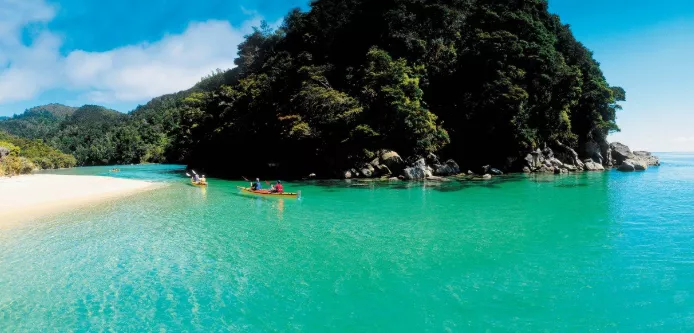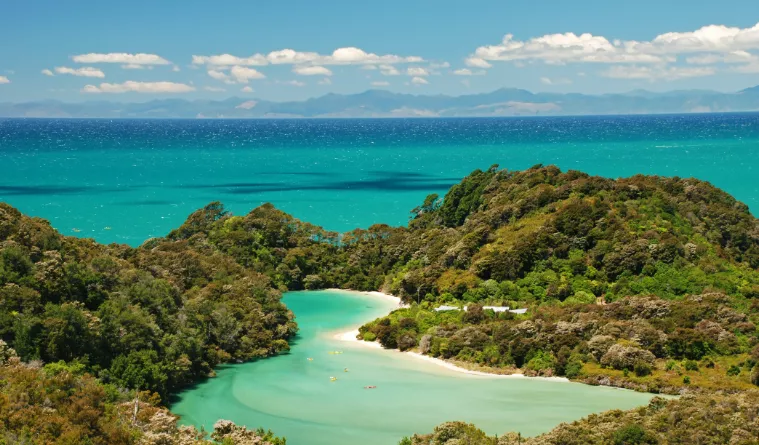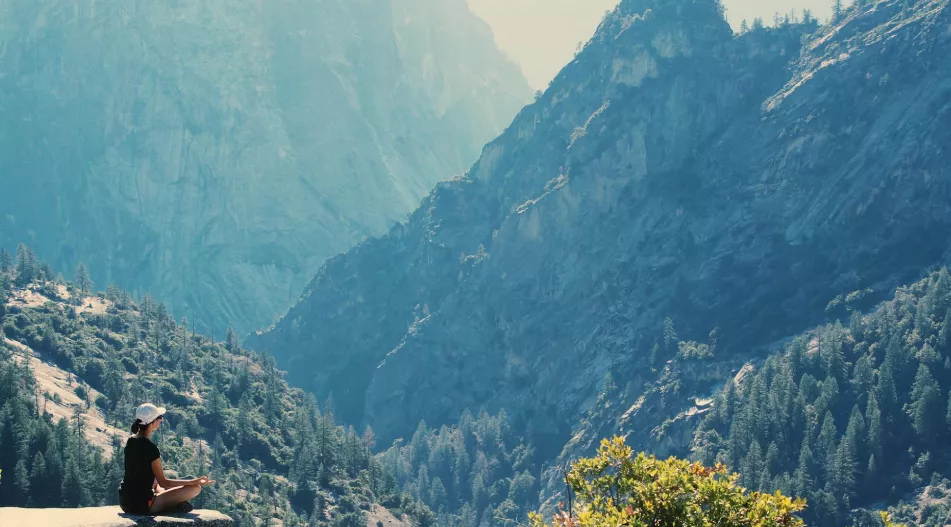Located in New Zealand, Abel Tasman National Park is a dream destination for outdoor enthusiasts. Nestled at the northernmost tip of the South Island, this compact national park is rich with wildlife, golden beaches, and lush forests. Whether you’re into kayaking, hiking, or simply soaking up the scenery, there’s something here for everyone. This guide will help you plan an unforgettable adventure and uncover the park’s top attractions.
Everything You Need to Know
- Abel Tasman National Park is known for its stunning coastal scenery and diverse wildlife.
- Popular activities include kayaking, hiking, and scenic boat tours.
- The best access points to the park are Kaiteriteri and Marahau beaches.
- Plan your visit for the warmer months for the best weather and fewer crowds.
1. Discovering Abel Tasman National Park
Here we are at Abel Tasman National Park. Located atop New Zealand’s South Island. Don’t be fooled by its size; this national park has plenty to see. Imagine a place with golden beaches, azure seas, and verdant forests all in one. If you love being outside, you will really adore this place. Many different kinds of local guides are available to show you around.
Unique Features
To what extent is Abel Tasman unique? To begin, there is no better-known landmark than the Abel Tasman Coast Track. It draws hikers from all over the world because it is one of New Zealand’s Great Walks. However, hiking is just one aspect of the experience. You have the ideal places to unwind, the beaches with golden sand. On top of that, being a protected marine area, the park boasts incredibly clear water and an abundance of marine life. It’s undeniable that the aquarium is a remarkable location.
Historical Significance
Abel Tasman is more than simply a scenic area; it also has a rich history. In 1642, Abel Tasman became the first European explorer to lay eyes on New Zealand. The park is dedicated to him. It wasn’t until much later that the Maori people settled in the region. A wide variety of cultural experiences are available. Traces of its past and present are everywhere throughout the park. It’s a neat historical artifact that serves as a reminder of the site’s significance.
The natural beauty of the park is enhanced by the unique blend of stories and traditions that have developed here as a result of the park’s history, which is influenced by both European exploration and the rich Maori legacy.
Here’s a brief look at some key historical periods:
- Pre-European Maori Settlement
- Abel Tasman’s Arrival (1642)
- Early European Settlement
- Establishment of the National Park

2. Adventure Activities in Abel Tasman National Park
Kayaking the Coastline
Kayaking is undoubtedly a popular activity among visitors to Abel Tasman. Imagine yourself gently floating across placid waters, discovering secret coves, and experiencing the breathtaking coastline of the park up close. Kayaks are available for rent, or you can sign up for a guided tour.
- Explore secluded beaches only accessible by water.
- Paddle through the Tonga Island Marine Reserve.
- Be vigilant for seals and dolphins!
A kayak provides a unique perspective of the park. Enjoy the peace and beauty of Abel Tasman at your speed with this fantastic method. Before you set out, double-check the weather and tides.
Think about kayaking adventures if you want a fantastic way to explore the park.
Hiking Trails
Incredible hiking trails abound in Abel Tasman, ranging from leisurely beach strolls to strenuous multi-day hikes. Famous for its beautiful scenery, verdant woods, and breathtaking vistas, the Abel Tasman Coast Track is a must-do for everyone visiting New Zealand.
- Abel Tasman Coast Track: The classic multi-day hike.
- Pitt Head Loop Track: A shorter, scenic option.
- Inland Tracks: Explore the park’s interior forests.
Exciting Boat Tours
If you’re seeking a less hectic approach to visiting the park, a picturesque cruise could be the perfect choice. You can enjoy a scenic cruise along the coast, taking in the park’s top attractions, without having to exert any effort. Just kick back, relax, and take in the scenery. Beaches with swimming and short hikes are even an option on some cruises. If you want to see the stunning scenery of Abel Tasman without sacrificing comfort, the boat is a fantastic choice.
- Enjoy panoramic views of the coastline.
- Learn about the park’s history and ecology from knowledgeable guides.
- Spot wildlife from the comfort of the boat.
Wildlife and Natural Beauty
Diverse Flora and Fauna
Abel Tasman National Park boasts an abundance of diverse plant and animal species. The native woodlands, dense with exotic trees and ferns, are a sight to behold. Silver ferns—New Zealand’s de facto national emblem—grow abundantly across the park. Birdlife is also plentiful: tuis are often heard before they’re seen, thanks to their distinctive, almost ringtone-like calls. Along the coast, you might spot the charming little blue penguins. With its rich biodiversity and stunning landscapes, the park is an ideal destination for outdoor adventures.
Marine Life
Yes, this place is home to some truly unique marine creatures. You might see dolphins playing in the waves, seals lounging on the rocks, and schools of fish swimming all around. During migration season, you may even be lucky enough to spot a whale. Snorkeling here is a must—the water is incredibly clear. If you’re fortunate, you could even catch sight of a stingray gliding among starfish and sea urchins. It’s better than swimming in an aquarium—because your sight is the real thing.
Stunning Landscapes
Let’s be honest—everyone comes for the landscapes. Golden beaches meet the blue ocean, all framed by lush green trees. One of the most iconic sights is Split Apple Rock—famous and even more stunning in person. The calm bays are perfect for kayaking or just unwinding on the shore. And the sunsets? Absolutely breathtaking. Trust me, you’ll want to photograph everything. This place has the ability to uplift your spirits.
But the park’s beauty goes beyond what you can see—it’s about how it makes you feel. There’s nothing like being out in the fresh air, listening to the waves, and stargazing at night. It’s nature at its most soul-soothing.
3. Accessing Abel Tasman National Park
Transportation Options
Getting to Abel Tasman National Park isn’t particularly difficult, but it does require some preparation. Flying into Nelson Airport is often the best option, especially if you’re short on time. The park’s main entry points are roughly an hour’s drive from the airport. Renting a car is ideal if you want to explore at your pace. Alternatively, shuttle buses run from Nelson—these are convenient, affordable, and save you from having to drive. Be careful if you’re not used to driving on narrow, winding roads.
Entry Points
There are several main access points to the park, each offering something different. Kaiteriteri is a popular choice thanks to its variety of water-based activities, including kayaking and water taxis. Marahau, another frequently used starting point, is especially known for its walking tracks. From both of these towns, water taxis can take you to various spots along the coast. For a quieter and more remote experience, consider Totaranui at the park’s northern end. It’s accessible by road, although the journey can be a bit long. The best entry point for you will depend on your schedule and interests.
Guided Tours
If you’re unsure about navigating the park alone or want a deeper understanding of its ecology and history, a guided tour is a great option. Tour providers offer everything from half-day kayaking trips to multi-day hiking adventures. A knowledgeable guide can share insights into the park’s Māori heritage, native wildlife, and plant life. Plus, guided tours handle all the logistics, allowing you to relax and enjoy the scenery. Common tour options include
- Kayaking tours
- Hiking tours
- Sailing tours
When I was a little girl, I remember getting lost in the park for the first time. I hadn’t realized how unprepared I was until I became slightly disoriented on one of the trails. Everything changed when I joined a guided tour. The guide had extensive knowledge of the area, shared local legends, and guided us to some truly stunning spots. The experience became not only more enjoyable but far more educational.
Best Times to Visit Abel Tasman National Park
Seasonal Highlights
When to visit Abel Tasman really depends on what you’re looking for. The summer months (December–February) are perfect for swimming and kayaking, thanks to warm temperatures and long sunny days. The trade-off? The trade-off is more crowds and higher prices. If hiking is your priority, spring (September–November) and autumn (March–May) offer cooler weather and fewer visitors. From June through August, the park is at its quietest, but you’ll need to prepare for unpredictable weather and the possibility that some activities may be unavailable.
Weather Considerations
Abel Tasman generally enjoys mild weather year-round, but it’s still important to pack appropriately. Summer highs usually sit in the mid-70s °F (mid-20s °C), making it ideal for beach days. However, rain is possible at any time, so bringing a waterproof jacket and layers is a smart move. In winter, temperatures can dip into the 40s °F (single digits °C), so warm clothing is essential. It’s crucial to closely monitor the forecast if you’re planning to kayak or embark on a multi-day hike.
Crowd Management
If you’re not a fan of crowds, you might want to avoid the park during summer and school holidays. Spring and autumn offer a much more peaceful experience, with fewer people on the trails and beaches. Weekdays are generally quieter than weekends, no matter the season. During peak times, be sure to book your accommodation and tours well in advance. Consider going during the off-season or exploring the park’s less-traveled areas for a more solitary experience.
Spring and autumn, also known as the shoulder seasons, offer the ideal combination of favorable weather conditions and reduced crowds. You’ll get a more relaxed experience and easier access to popular spots.
Quick Guide:
- Summer (Dec–Feb): Best for swimming and sunbathing, but the busiest time.
- Autumn (Mar.–May): Ideal for hiking; fewer people and comfortable temperatures.
- Winter (Jun–Aug): Quietest season; limited activities and cooler weather.
- Spring (Sep–Nov): Beautiful wildflowers, pleasant weather, ideal for outdoor adventures.
Final Thoughts on Your Abel Tasman Adventure
Making lasting memories is what a trip to Abel Tasman National Park is all about. Whether you’re hiking through lush forest trails or sailing along the golden coastline, there’s always something special waiting to be discovered. The stunning beaches, rich wildlife, and peaceful atmosphere make this an ideal destination for anyone looking to unwind and reconnect with nature. So pack your bags, hit the road, and get ready for an unforgettable journey!
Answers to Common Questions
- What is Abel Tasman National Park known for?
Abel Tasman is renowned for its golden beaches, clear turquoise waters, and excellent hiking trails. It’s a paradise for outdoor lovers.
- How can I explore the park?
You can hike, kayak, or take a scenic cruise—each option offers a different way to enjoy the park’s breathtaking views.
- What kinds of animals can I expect to see?
The park is home to seals, dolphins, and a wide variety of native birds. You’ll also come across rare trees and unique native flora.
Everything you need—flights, hotels, car rentals, bike rentals, taxis, and eSIMs for travelers—book it all with Voyage Magnets.





